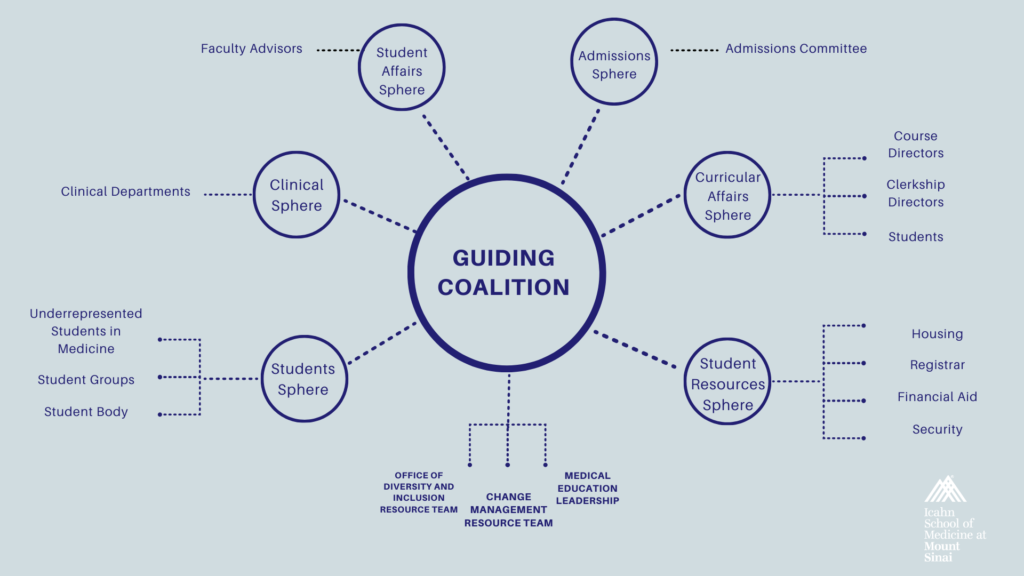The Guiding Coalition is launching twenty change targets this year. This is the first year we have created a comprehensive strategy that includes all of the actions or projects addressing racism in bias across the medical school. A tremendous amount of work and strategy went into planning to ensure we are working collaboratively.
Let us know what you think of the 2021 change targets. Share your comments and feedback.
To learn more about the Guiding Coalition’s approach to developing the Comprehensive, Strategic Plan for 2021 to address racism across all functional areas of the School.
What's a Change Target?
A change target is an incremental desired outcome or end result of the Guiding Coalition’s actions that strategically leads the school towards the Racism and Bias Initiative’s vision to become a health system and health professions school with the most diverse workforce, providing health care and education that is free of racism and bias. Although our journey of transformation is guided by our vision, each year we revisit and revise our change targets because transformational change is largely determined through trial and error as new information is gathered. This is why we course-correct throughout the year as the change process emerges. Each month we will continue to share action updates on our progress.
The structure of the Guiding Coalition allows us to leverage and work with twelve different stakeholders (see graphic below) to ensure we are addressing racism across all of the functional areas of the medical school. This year we are excited to include even more students in the process.

Many of the change targets build on the success of last year’s change targets that focused on training the admissions committee, engaging the pediatrics department in Chats for Change, facilitating growth in personal awareness and anti-racist knowledge and skills among course directors, and working with student advisors on an appreciative advising model. We are also introducing new change targets this year to broaden the scope of the work by creating a new Medical Education Program Objectives (MEPO), rolling out a new equity playbook, strengthening and building new admissions pathways, understanding barriers and mediators around student participation in addressing racism, compensating students for anti-racism work, learning about staff experience encountering racism and bias at work, and much more.
Below you will find the Guiding Coalition’s change targets organized by sphere and school-wide projects. Check out the progress tracker to learn more about the objectives or steps each sphere will take towards achieving each change target.
Admissions Sphere
- Further educate committee members to engage in admissions work from a lens of equity.
- Reflect on and broaden the education and training of the admissions committee to continually engage in admissions work from an equity lens.
- Strengthen and explore existing relationships with schools/organizations/programs in order to enhance existing admissions pathways and brainstorm about new pathways specifically for students from backgrounds underrepresented in science and medicine to matriculate to the Icahn School of Medicine at Mount Sinai.
- Establish partnerships with the Assessment and Evaluation team and the Student Affairs team to track aggregate student outcome data (academic and professionalism) to better inform Admissions work
Clinical Sphere
- Using an interprofessional lens, establishing and maintaining an environment across the Mount Sinai Health System (MSHS) that allows reporting of racism and bias to be empowering, safe, accountable to the community, anti-racist, provides remediation where needed, and closes the loop by providing feedback to the community.
Curricular Affairs
- Create a new Medical Education Program Objectives (MEPO) that addresses racism and bias.
- Increase the diversity of the standardized patient (SP) population to better reflect the race/ethnicity make-up of the patient population.
- Develop a standardized patient session on navigating racist patients or colleagues during clinical encounters, both as a URiSM student and an ally.
- Diversify patient representation of black and marginalized individuals in settings not limited to lecture images, symptom presentation, and case examples across all four years of the curriculum.
- Identify the role of SES, race, & gender on student scholarly outcomes/products (Scholarly Year, conference presentations, Distinction in Research and other awards) to enhance equity in scholarship.
- Growth in personal awareness and anti-racist knowledge and skills among course and clerkship directors who are front-line voices to students and faculty.
Student Sphere
- To understand barriers and mediators around and to develop potential interventions to increase student participation in addressing racism.
Student Affairs Sphere
- Adopt and support advising practices by Faculty Advisors that actively address racism, promote equity and improve trust among students and Student Affairs.
Student Resources Sphere
- Develop and implement an equity lens playbook, a tool for equitable decision-making across the Department of Medical Education.
- Compensate students for scholarly work related to racism and bias.
- Engage the ISMMS Advisory Committee on Campus Safety in identifying and addressing issues related to racism and bias.
- Learn about staff experience encountering racism and bias at work.
Medical School-Wide Initiatives
- Create a mission statement for medical education reflects our stance on denouncing racism and our commitment to racial justice.
- Conduct quarterly town hall meetings across the Medical and Grad Schools that aim to process, update, and coordinate responses to current events and community needs as they relate to racism and bias.
- Conduct a climate survey with faculty, staff, and students in the medical school and identify areas for intervention.
